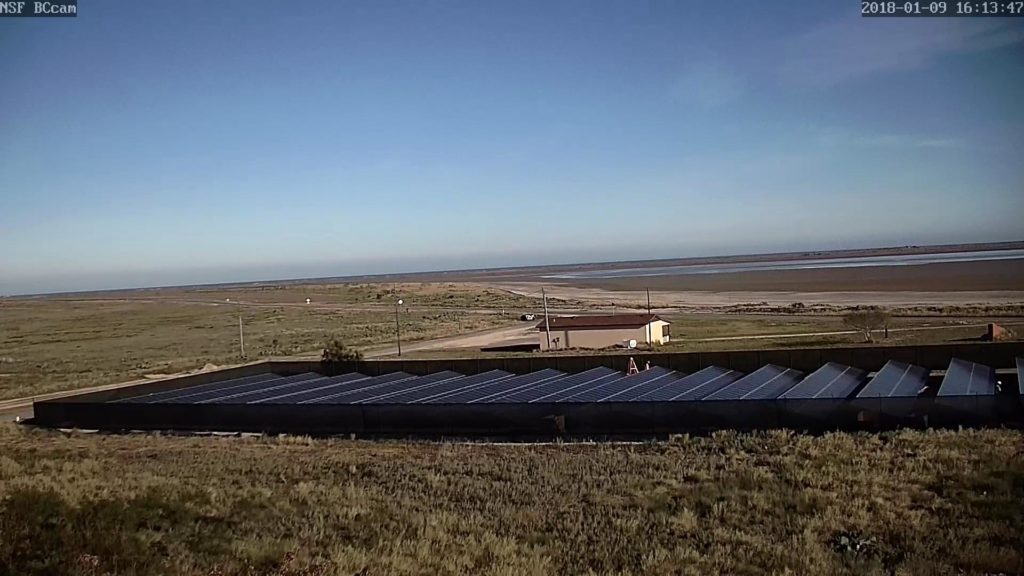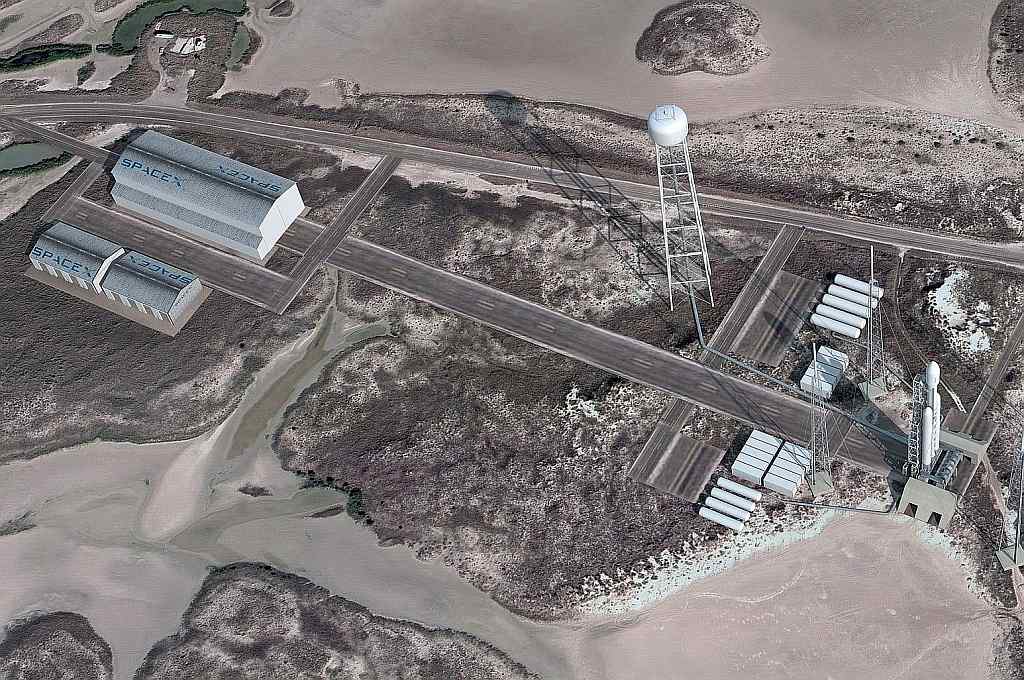

News
SpaceX could begin testing its Mars rocket in Texas by late 2018, early 2019
On the heels of a successful wet dress rehearsal for Falcon Heavy, SpaceX’s President and COO Gwynne Shotwell spoke briefly about SpaceX for an aerospace conference located at Texas’ Academy of Medicine, Engineering & Science. Ars Technica’s senior spaceflight editor Eric Berger was in attendance and provided a rough outline of live tweets during the first group of presentations.
While the phrasing cannot provide absolute confirmation, Berger summarized a statement by Shotwell suggesting that SpaceX’s Boca Chica, Texas launch site, currently in the early stages of construction, could be ready to host “vehicle tests” as soon as late 2018, early 2019. At this point in time, based on comments from Shotwell and CEO Elon Musk, it can be reasonably assumed that SpaceX’s Texas launch facilities will be dedicated mainly to the company’s interplanetary colonization efforts, and will probably be tailored to support the testing and eventual launches of BFR/BFS.
Some news from Shotwell: Brownsville launch site ready for vehicle tests in late 2018, early 2019. Move to launch site after that.
— Eric Berger (@SciGuySpace) January 11, 2018
After nine months of earnest construction and rehabilitation, SpaceX’s LC-40 pad was recently reactivated and has since supported two launches without any major hitches. At the same time, LC-39A in flux in order to support launches of SpaceX’s new Falcon Heavy rocket, the size of which required some concomitant upgrades to multiple ground systems. With both of those major tasks now effectively complete, SpaceX’s pad construction team is free to either refocus their efforts towards Boca Chica. Over the past several months, Boca Chica has seen a gradual but consistent level of development, mainly by way of unaffiliated SpaceX contractors. These changes have been dutifully tracked over the last several years on NASASpaceflight.com forums by a handful of friendly local residents interested in the changes coming to Boca Chica and Brownsville, Texas, a nearby town.
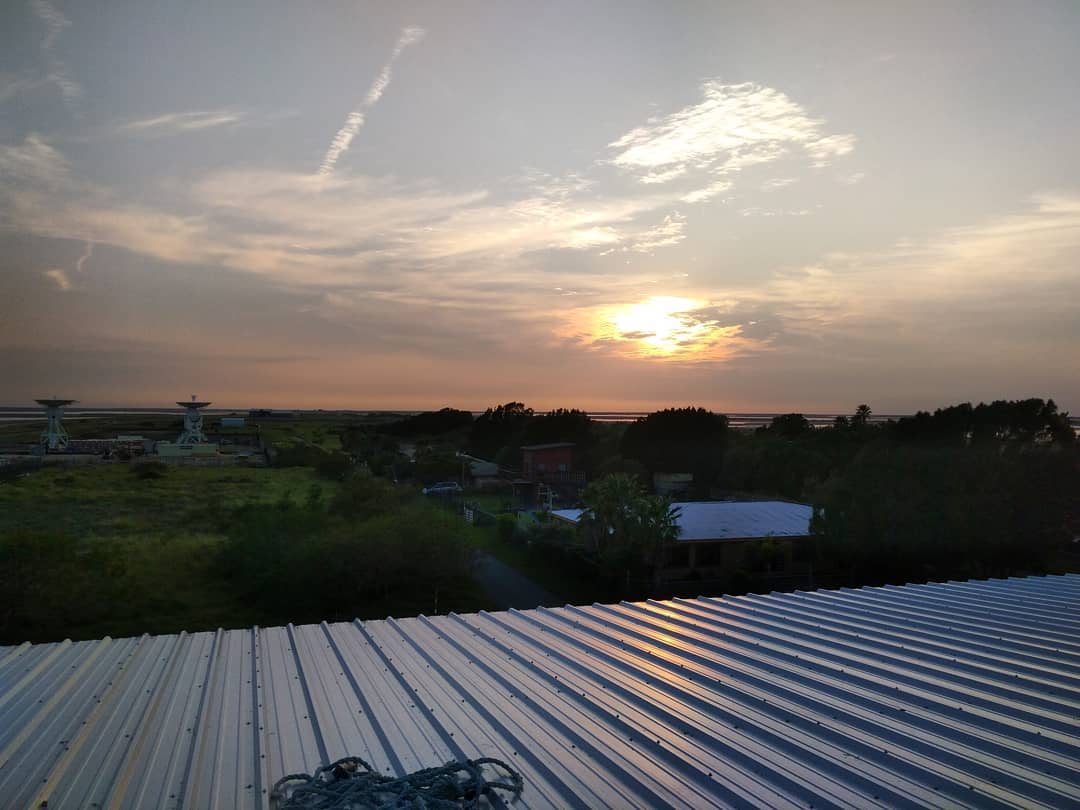
SpaceX’s Boca Chica facilities and STARGATE dishes (center-left) seen at sunset from the top of the giant crane garage. (anonymous Instagram user)
Most significantly, the last several months have seen three major developments. First and most prominently, a permanent facility called STARGATE externally appears complete and its two large radio communication dishes have been installed nearby. The STARGATE facility is a public-private partnership between the University of Texas at Brownsville (now part of University of Texas Rio Grande Valley) and SpaceX, with the academic components focusing on research that SpaceX undoubtedly has interest in: improved orbital spacecraft tracking and communications. Operationally, SpaceX will use the facilities to communicate with and operate its Crew Dragon spacecraft during launches, set to begin with an uncrewed demonstration mission as early as August 2018.
Second, an absolutely massive trolley crane appeared on SpaceX’s land and was eventually housed in an apparently purpose-built shed. The crane dwarfs anything currently used at SpaceX’s launch facilities and is almost certainly a custom-ordered piece of equipment, and thus would be both expensive and explicitly purposeful. What that purpose might be is currently unknown, but it is entirely plausible that the crane is intended to support initial testing (or even limited manufacturing) of SpaceX’s first BFS prototype rockets. This speculation has now been strengthened by Shotwell’s January 11 2018 comment on potential “vehicle tests” occurring at the site within a year or so, and also meshes with a presentation she gave in October 2017 at MIT. It also fits with Elon Musk’s 2017 IAC comments that BFR construction tooling and facilities were respectively already ordered and under construction.
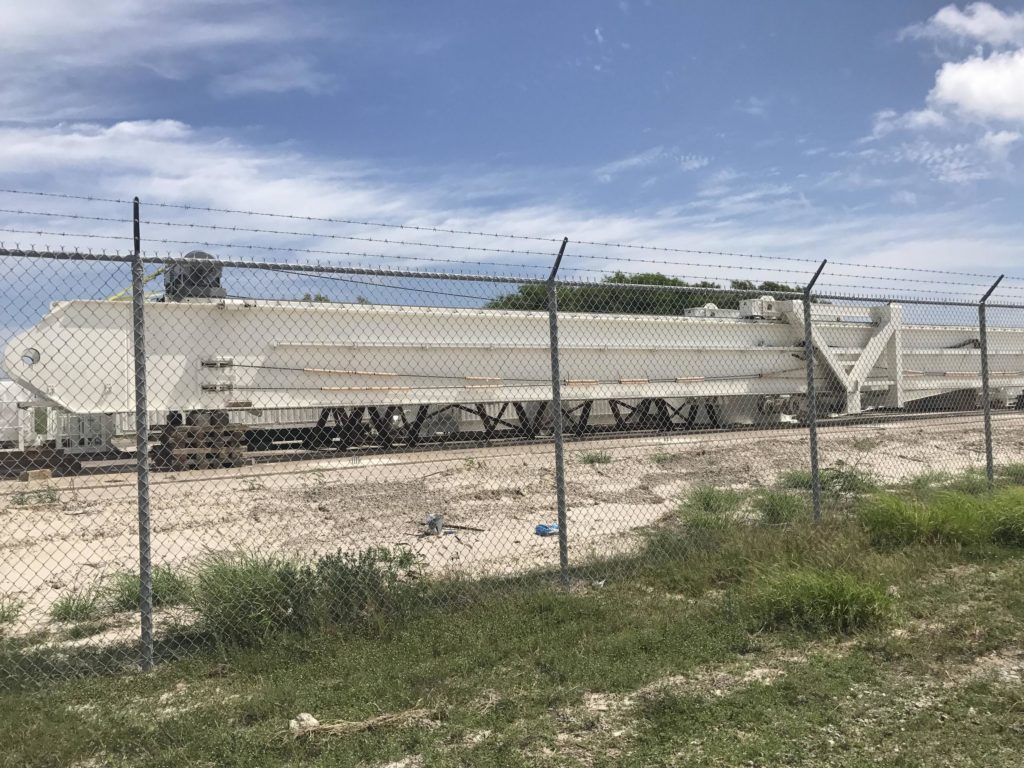
The boom of the giant crane seen in late 2017, parked at SpaceX’s Boca Chica facilities. (Reddit /u/ ticklestuff)
Third and last, the aforementioned SpaceX-following locals observed the early stages of a solar power install beginning on some of SpaceX’s Boca Chica land in late 2017, and also noted that at least some of its contractors were part of Tesla Solar. Plans and permits for solar power were acknowledged as far back as 2014, although at that point the contractor was Solar City (now a part of Tesla). A handful of months later, NASASpaceflight user and all-around awesome guy Nomadd has installed a webcam on a tall pole with a wonderful view of both the solar installation (now nearly completed) and STARGATE. The acre of solar panels can be expected to produce as much as half a megawatt (MW) at peak sun, likely more than enough to offset a considerable amount of the facilities’ electricity usage even after it begins to be see serious use.
- A Tesla Energy/Solar City contractor’s vehicle spotted at the Boca Chica solar installation. (NSF /u/ bocachicagal)
- As of last week, the solar installation appears to be nearly complete. (NSF /u/ Nomadd)
Originally announced as an additional Falcon launch facility in 2014, Boca Chica has remained relatively dormant over the last three years, and it is truly exciting to see activity ramping up. There are admittedly significant barriers that will prevent SpaceX from effortlessly repurposing its Boca Chica pad for BFR, a much larger rocket. If SpaceX intends to do that, they will almost certainly need to pass a significantly updated FAA environmental impact review and account for any remediations that might be required. Still, that is a small ask for for Brownsville’s local government and Texas as a whole, both of which have clearly enjoyed and begun to benefit from SpaceX’s presence in the otherwise unknown area. SpaceX is unlikely to give up on Boca Chica in the near term, so long as Ms. Shotwell maintains her belief that it is effectively the perfect location for BFR launches.
Overall, Shotwell’s comments over the last several months and today in particular are increasingly encouraging, and things are likely to only speed up as 2018 progresses, allowing SpaceX to focus more and more of its expertise on BFR, BFS, and its South Texas testing and launch facilities.
Full disclosure: As Shotwell did not specify which vehicle or vehicles could be expected to begin testing in 2018/2019, it is possible that Falcon 9, not BFR, was the statement’s target. This article should be taken with a grain of salt, as it is educated speculation based upon public information from SpaceX executives and Texas contractors. Teslarati reached out to SpaceX for additional information, but the company was unable to comment further on Shotwell’s presentation at the moment.
Elon Musk
Tesla begins expanding Robotaxi access: here’s how you can ride
You can ride in a Tesla Robotaxi by heading to its website and filling out the interest form. The company is hand-picking some of those who have done this to gain access to the fleet.
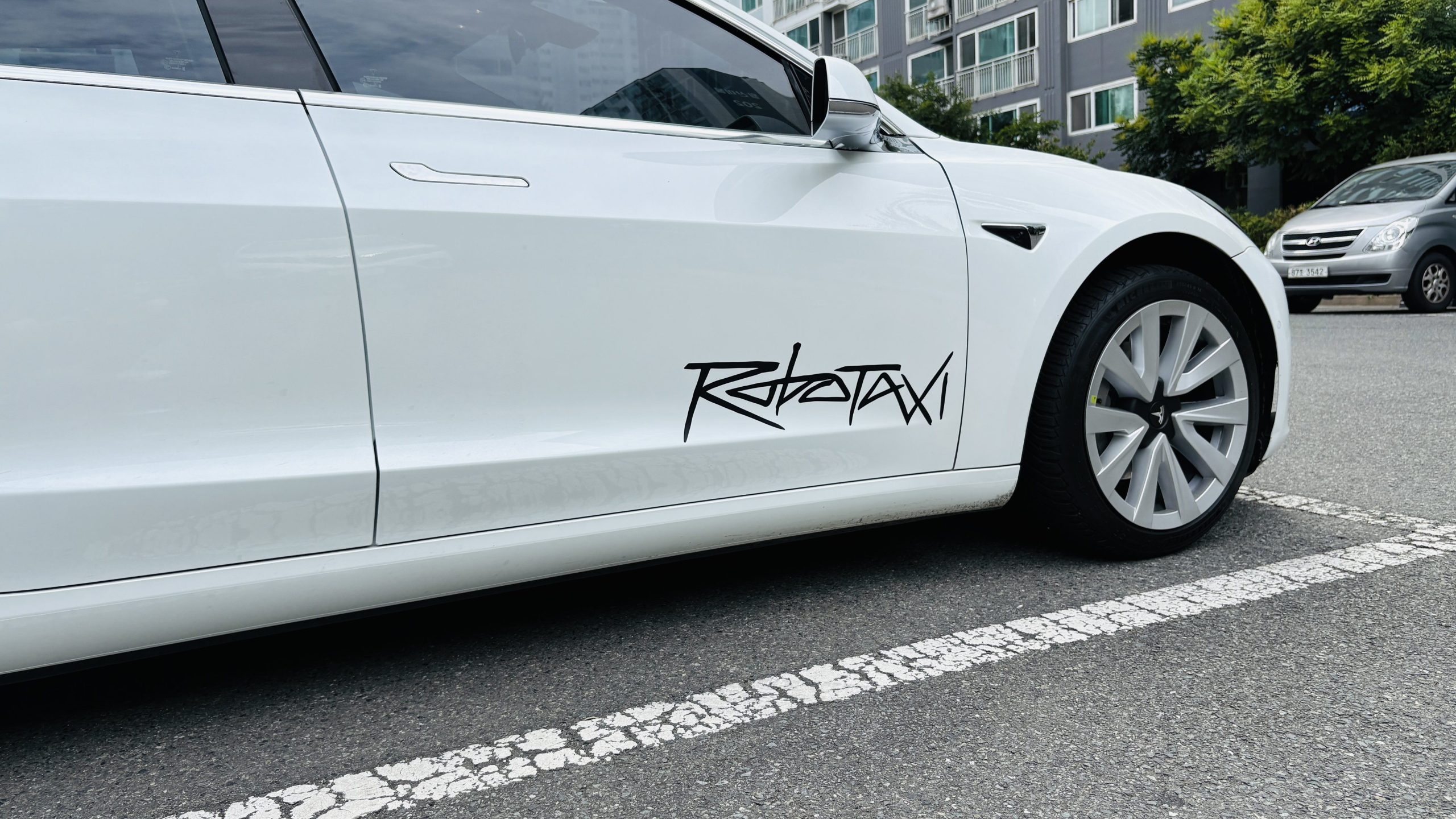
Tesla has begun expanding Robotaxi access beyond the initial small group it offered rides to in late June, as it launched the driverless platform in Austin, Texas.
The small group of people enjoying the Robotaxi ride-hailing service is now growing, as several Austin-area residents are receiving invitations to test out the platform for themselves.
The first rides took place on June 22, and despite a very small number of very manageable and expected hiccups, Tesla Robotaxi was widely successful with its launch.
Tesla Robotaxi riders tout ‘smooth’ experience in first reviews of driverless service launch
However, Tesla is expanding the availability of the ride-hailing service to those living in Austin and its surrounding areas, hoping to gather more data and provide access to those who will utilize it on a daily basis.
Many of the people Tesla initially invited, including us, are not local to the Austin area.
There are a handful of people who are, but Tesla was evidently looking for more stable data collection, as many of those early invitees headed back to where they live.
The first handful of invitations in the second round of the Robotaxi platform’s Early Access Program are heading out to Austin locals:
I just got a @robotaxi invite! Super excited to go try the service out! pic.twitter.com/n9mN35KKFU
— Ethan McKanna (@ethanmckanna) July 1, 2025
Tesla likely saw an influx of data during the first week, as many traveled far and wide to say they were among the first to test the Robotaxi platform.
Now that the first week and a half of testing is over, Tesla is expanding invites to others. Many of those who have been chosen to gain access to the Robotaxi app and the ride-hailing service state that they simply filled out the interest form on the Robotaxi page of Tesla’s website.
That’s the easiest way you will also gain access, so be sure to fill out that form if you have any interest in riding in Robotaxi.
Tesla will continue to utilize data accumulated from these rides to enable more progress, and eventually, it will lead to even more people being able to hail rides from the driverless platform.
With more success, Tesla will start to phase out some of the Safety Monitors and Supervisors it is using to ensure things run smoothly. CEO Elon Musk said Tesla could start increasing the number of Robotaxis to monitors within the next couple of months.
Elon Musk
Tesla analyst issues stern warning to investors: forget Trump-Musk feud
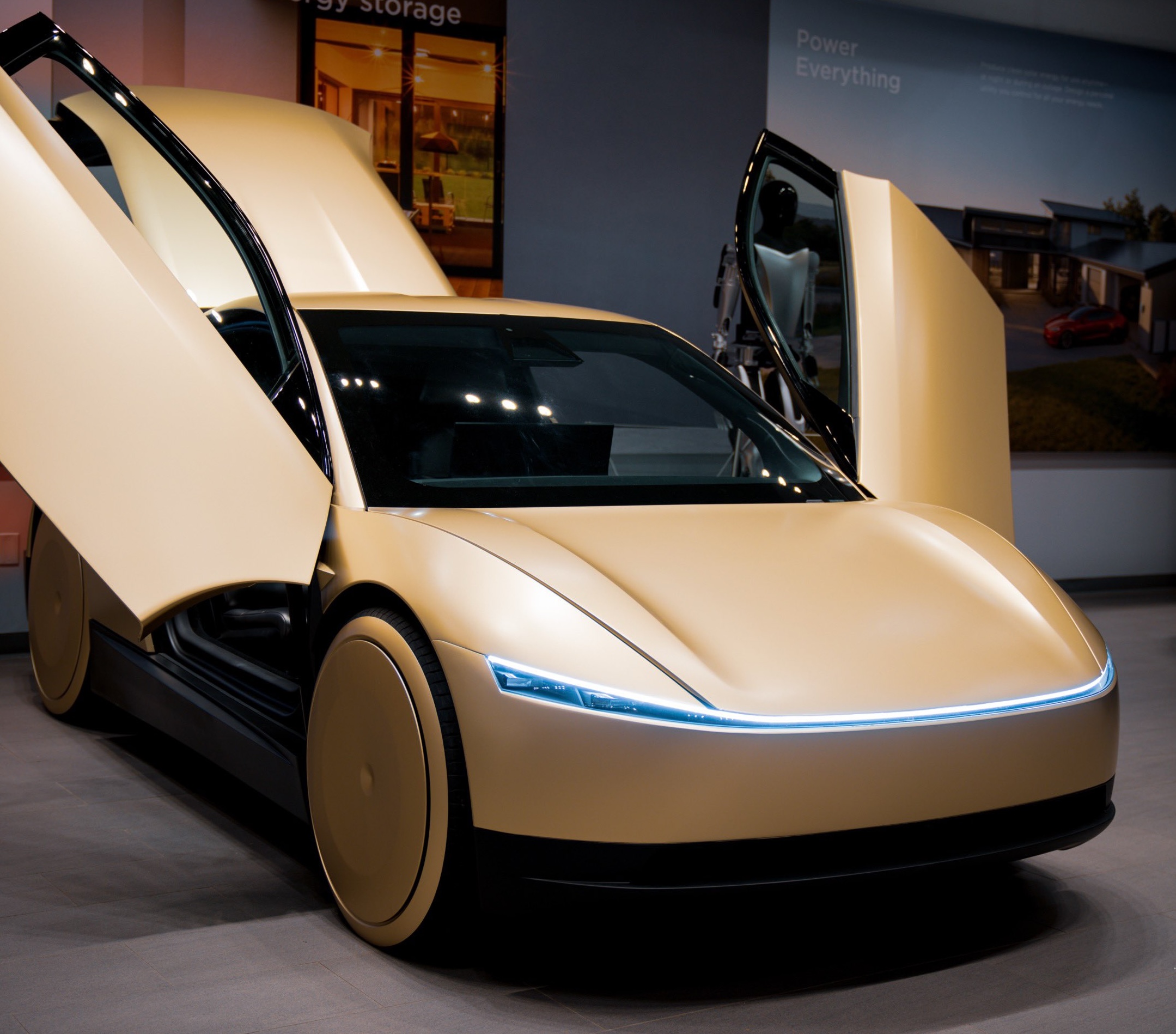
A Tesla analyst today said that investors should not lose sight of what is truly important in the grand scheme of being a shareholder, and that any near-term drama between CEO Elon Musk and U.S. President Donald Trump should not outshine the progress made by the company.
Gene Munster of Deepwater Management said that Tesla’s progress in autonomy is a much larger influence and a significantly bigger part of the company’s story than any disagreement between political policies.
Munster appeared on CNBC‘s “Closing Bell” yesterday to reiterate this point:
“One thing that is critical for Tesla investors to remember is that what’s going on with the business, with autonomy, the progress that they’re making, albeit early, is much bigger than any feud that is going to happen week-to-week between the President and Elon. So, I understand the reaction, but ultimately, I think that cooler heads will prevail. If they don’t, autonomy is still coming, one way or the other.”
BREAKING: GENE MUNSTER SAYS — $TSLA AUTONOMY IS “MUCH BIGGER” THAN ANY FEUD 👀
He says robotaxis are coming regardless ! pic.twitter.com/ytpPcwUTFy
— TheSonOfWalkley (@TheSonOfWalkley) July 2, 2025
This is a point that other analysts like Dan Ives of Wedbush and Cathie Wood of ARK Invest also made yesterday.
On two occasions over the past month, Musk and President Trump have gotten involved in a very public disagreement over the “Big Beautiful Bill,” which officially passed through the Senate yesterday and is making its way to the House of Representatives.
Musk is upset with the spending in the bill, while President Trump continues to reiterate that the Tesla CEO is only frustrated with the removal of an “EV mandate,” which does not exist federally, nor is it something Musk has expressed any frustration with.
In fact, Musk has pushed back against keeping federal subsidies for EVs, as long as gas and oil subsidies are also removed.
Nevertheless, Ives and Wood both said yesterday that they believe the political hardship between Musk and President Trump will pass because both realize the world is a better place with them on the same team.
Munster’s perspective is that, even though Musk’s feud with President Trump could apply near-term pressure to the stock, the company’s progress in autonomy is an indication that, in the long term, Tesla is set up to succeed.
Tesla launched its Robotaxi platform in Austin on June 22 and is expanding access to more members of the public. Austin residents are now reporting that they have been invited to join the program.
Elon Musk
Tesla surges following better-than-expected delivery report
Tesla saw some positive momentum during trading hours as it reported its deliveries for Q2.

Tesla (NASDAQ: TSLA) surged over four percent on Wednesday morning after the company reported better-than-expected deliveries. It was nearly right on consensus estimations, as Wall Street predicted the company would deliver 385,000 cars in Q2.
Tesla reported that it delivered 384,122 vehicles in Q2. Many, including those inside the Tesla community, were anticipating deliveries in the 340,000 to 360,000 range, while Wall Street seemed to get it just right.
Tesla delivers 384,000 vehicles in Q2 2025, deploys 9.6 GWh in energy storage
Despite Tesla meeting consensus estimations, there were real concerns about what the company would report for Q2.
There were reportedly brief pauses in production at Gigafactory Texas during the quarter and the ramp of the new Model Y configuration across the globe were expected to provide headwinds for the EV maker during the quarter.
At noon on the East Coast, Tesla shares were up about 4.5 percent.
It is expected that Tesla will likely equal the number of deliveries it completed in both of the past two years.
It has hovered at the 1.8 million mark since 2023, and it seems it is right on pace to match that once again. Early last year, Tesla said that annual growth would be “notably lower” than expected due to its development of a new vehicle platform, which will enable more affordable models to be offered to the public.
These cars are expected to be unveiled at some point this year, as Tesla said they were “on track” to be produced in the first half of the year. Tesla has yet to unveil these vehicle designs to the public.
Dan Ives of Wedbush said in a note to investors this morning that the company’s rebound in China in June reflects good things to come, especially given the Model Y and its ramp across the world.
He also said that Musk’s commitment to the company and return from politics played a major role in the company’s performance in Q2:
“If Musk continues to lead and remain in the driver’s seat, we believe Tesla is on a path to an accelerated growth path over the coming years with deliveries expected to ramp in the back-half of 2025 following the Model Y refresh cycle.”
Ives maintained his $500 price target and the ‘Outperform’ rating he held on the stock:
“Tesla’s future is in many ways the brightest it’s ever been in our view given autonomous, FSD, robotics, and many other technology innovations now on the horizon with 90% of the valuation being driven by autonomous and robotics over the coming years but Musk needs to focus on driving Tesla and not putting his political views first. We maintain our OUTPERFORM and $500 PT.”
Moving forward, investors will look to see some gradual growth over the next few quarters. At worst, Tesla should look to match 2023 and 2024 full-year delivery figures, which could be beaten if the automaker can offer those affordable models by the end of the year.
-

 Elon Musk2 days ago
Elon Musk2 days agoTesla investors will be shocked by Jim Cramer’s latest assessment
-

 News1 week ago
News1 week agoTesla Robotaxi’s biggest challenge seems to be this one thing
-

 Elon Musk2 weeks ago
Elon Musk2 weeks agoElon Musk slams Bloomberg’s shocking xAI cash burn claims
-

 News2 weeks ago
News2 weeks agoTexas lawmakers urge Tesla to delay Austin robotaxi launch to September
-

 Elon Musk1 week ago
Elon Musk1 week agoFirst Look at Tesla’s Robotaxi App: features, design, and more
-
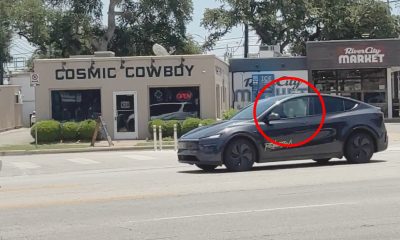
 Elon Musk2 weeks ago
Elon Musk2 weeks agoTesla Robotaxis are becoming a common sight on Austin’s public roads
-
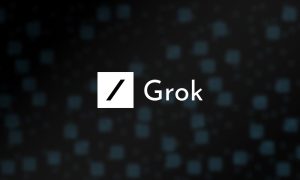
 Elon Musk2 weeks ago
Elon Musk2 weeks agoxAI’s Grok 3 partners with Oracle Cloud for corporate AI innovation
-

 Elon Musk2 weeks ago
Elon Musk2 weeks agoSpaceX President meets India Minister after Starlink approval


